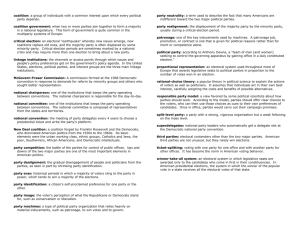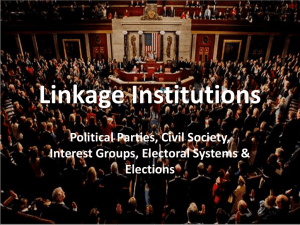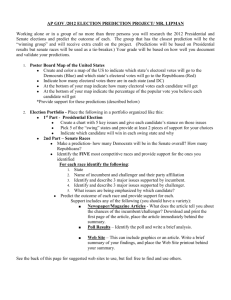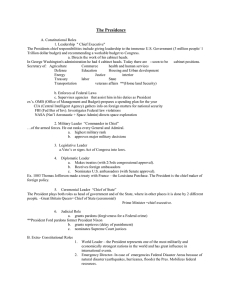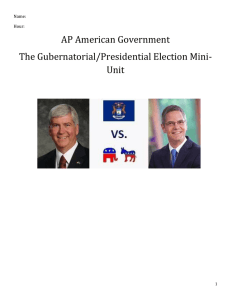Chapter 10.2
advertisement
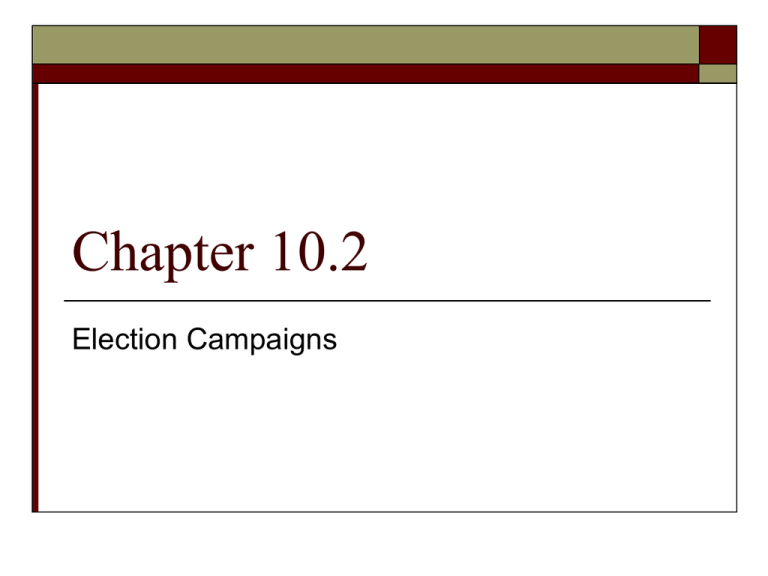
Chapter 10.2 Election Campaigns Types of Elections Besides primary elections, there are three types of elections in the U.S.: general elections, elections on issues and special elections. After primary races narrow the field, voters choose candidates in a general election that occurs on the 1st Tuesday after the 1st Monday in November. continued All seats in the House and about 1/3rd of the seats in the Senate are at stake in general elections every even-numbered year. Presidents are elected every four years. In all except presidential races, the candidate with the majority of the popular vote wins. If the count is very close, the loser may demand a recount. If neither candidate for president wins a majority of electoral votes, the House elects the president. continued Citizens can propose new laws or state constitutional amendments through an initiative. If enough voters sign a petition, the proposed law, or proposition, is put on the ballot at the next general election. Citizens may petition to have a state or local law referred, or sent back, to the voters as a referendum on the ballot. The voters can then approve or reject the law. continued A runoff is a special election held to determine a winner when none of the candidates wins a majority in the general election. A recall is a special election in which citizens can vote to remove an official from office. Presidential Elections The three steps in a presidential election are nomination, the campaign and the vote. Presidential hopefuls start campaigning for their party’s nomination a year before the election. continued Past national conventions were full of political dealing to win delegates’ support for a candidate. In recent years the conventions have lost their main purpose – choosing a nominee. The primaries do that now. Instead, the conventions serve to rally party members for the campaign ahead. continued By early September, candidates are already giving speeches, appearing on TV and holding news conferences. They may face their opponents in televised debates. continued Presidents are chosen by the Electoral College, not by direct popular vote. Each state has a slate of electors pledged to each candidate. The popular vote chooses the slate of electors. In the winner-take-all system, the candidate who wins the popular vote takes all the state’s electoral votes. continued The winning electors cast their votes in their state’s capital in December. Congress counts the votes. Each state has one elector for each of its U.S. senators and representatives. To win, a candidate must win 270 of the 538 electoral votes. continued The Electoral College system was a compromise. Some Founders wanted direct popular election of the president. Others wanted Congress to name the president. Their compromise was to have the state legislatures choose electors. Now the voters in each state directly choose the electors. continued Some critics charge that large states with many electors have too much influence in deciding elections. Others claim that including votes for senators gives small states unfair power. Still others point out that under the winner-take-all system, a candidate who loses the popular vote can still win the electoral vote and presidency. continued A 3rd party candidate could win enough electoral votes to prevent either major party candidate from receiving a majority and then bargain to release electoral votes. Also, the winner-take-all system makes it hard for 3rd party candidates to take any electoral votes.



